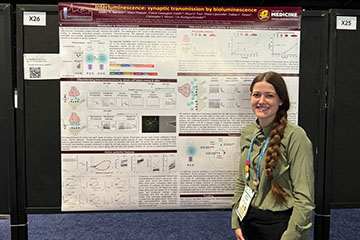Algal blooms can be dangerous
Biology faculty member Hunter Carrick tells how to spot them, what to do if you make contact
Experts on Point is a University Communications series focusing on CMU faculty who have special insights into interesting, important and timely topics.
Hot summers for many in Michigan mean heading to one of our abundant lakes for a relaxing dip. Unfortunately, along with rising temperatures is an increased likelihood that people may come in contact with algae that potentially can cause unpleasant or even harmful conditions for them and their pets.

Hunter Carrick, a Central Michigan University Biology faculty member, is an expert on pollution problems in aquatic ecosystems (lakes and stream), particularly those in the Great Lakes region. We talked with him to learn more about how algal blooms grow and what makes some dangerous.
Q: What are algal blooms?
A: They are microscopic algae that multiply and grow in a confined area to the point that you can see them as particles and flakes suspended in the water. Most are harmless and are an important seasonal food for a variety of invertebrates, mollusks, and small fish.
Q: What makes for a toxic algal bloom?
A: These are conditions when rapidly-reproducing algae — typically blue-green in color in freshwater and referred to as cyanobacteria — can be found floating in water or washed up on shore. They produce chemicals as by-products of their normal growth that can be dangerous (even toxic) to a range of invertebrates, vertebrates and humans as the chemical becomes more concentrated in the water. The production of these biochemicals have been linked to a range of harmful conditions, including skin rashes, changes to nervous systems and potentially making pets deathly sick. In addition, when the algae die, the oxygen that it takes to break them down takes oxygen from fish and invertebrates, killing them.
Q: What causes harmful algae?
A: The blue-green algae thrive in waters that have an excess of nutrients, specifically phosphorus and nitrogen, which often are the result of household or industrial detergents, lawn fertilizers and urban and agricultural runoff. Some research points the occurrences of algal blooms to the rise of zebra and quagga mussels in the Great Lakes, which eat good algae and release — or avoid eating — blue-green algae in the water, leaving it to grow and concentrate throughout the summer.
Q: Does rising summer temperatures impact them?
A: Yes, the toxic blue-green algae often thrive as the summer progresses. The blooms benefit from the ample sunlight that promotes their growth and warms the temperature of the water. These same weather patterns can produce more intense rain storms, like those we have had during the late spring and summer, which deliver abundant nutrients like phosphorus and nitrogen which fuel more algae growth. The delivery of nutrients, coupled with consistently higher-than-average temperatures of Michigan's lakes, have in a sense created the perfect storm for algal blooms.
Q: What should people do if they contact or swallow HAB-contaminated water?
A: If you or your children experience symptoms such as runny eyes or nose, stomach pain, vomiting, diarrhea, seizures, weakness and/or headaches, go to the nearest urgent care or call poison control (800-222-1222).
Q: What about pets?
A: An animal that has gone in water contaminated with excessive algae should be rinsed off immediately. If a pet shows symptoms such as vomiting, diarrhea, staggering and seizures, they should be taken immediately to a veterinarian. It is also important to report the case to the Michigan Department of Rural Development at 800-292-3939 or by submitting a Reporting a Reportable Disease Form.
Q: What if I suspect that a body of water has HABs?
A: Contact the Department of Environment, Great Lakes and Energy at 800-662-9278 or algaebloom@Michigan.gov.
.jpeg?sfvrsn=2dd3cd2a_5)



